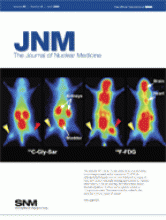Advantages in angiogenesis imaging: Hsu and Chen review the current state of anatomic, functional, and molecular imaging of angiogenesis, an intensely studied area of cancer research that holds great promise.
Page 511
Correlative imaging in hypoxia and angiogenesis: Langen and Eschmann provide an introduction to current imaging approaches in hypoxia and angiogenesis and preview an article on these topics in this issue of JNM.
Page 515
18F-FDG and tumor perfusion: Mullani and colleagues investigate whether early, first-pass 18F-FDG PET can be used to estimate regional blood flow in tumors, a technique with promise for facilities that lack cyclotrons for 15O-water production.
Page 517

Preoperative imaging in thyroid carcinoma: Koopmans and colleagues explore optimal imaging approaches (including 18F-DOPA PET, 18F-FDG PET, scintigraphic, CT, and MR imaging) in presurgical tumor localization in patients with recurrent medullary thyroid cancer.
Page 524

PET/CT in posttherapy HNSCC: Ong and colleagues assess the predictive utility of 18F-FDG PET/CT in patients with locoregional advanced head and neck squamous cell carcinoma after concurrent chemotherapy and radiation therapy.
Page 532
Scintigraphy and brachytherapy seeds: Kono and colleagues describe the use of a novel scintigraphic method for monitoring localization and migration of implanted 125I seeds after permanent brachytherapy for prostate cancer.
Page 541

Prevention of 131I-induced sialadenitis: Silberstein reports on a study designed to determine whether administration of pilocarpine can reduce the salivary symptoms of pain and xerostomia caused by 131I therapy for papillary and follicular thyroid carcinoma.
Page 546
MPS and stent prognosis: Zellweger and colleagues explore the ability of myocardial perfusion scintigraphy to predict events related to late stent thrombosis and restenosis after percutaneous coronary intervention with drug-eluting stents.
Page 550
Progenitor cells after coronary recanalization: Kendziorra and colleagues investigate relative changes in human myocardial perfusion and glucose metabolism induced by intracoronary administration of blood-derived circulating progenitor cells after recanalization of total coronary occlusion.
Page 557

CTA vs. SPECT for stenosis severity: Sato and colleagues compare the clinical value of information from 64-slice CT angiography and stress myocardial perfusion imaging in 104 patients with suspected coronary artery disease.
Page 564

18F-DOPA PET in neuroendocrine tumors: Jager and colleagues provide an educational overview of the radiosynthesis, uptake, and metabolism of 18F-DOPA and its clinical applications in PET imaging of neuroendocrine tumors.
Page 573

Modeling considerations for 11C-CUMI-101: Milak and colleagues report on studies of optimal modeling parameters for this 5-HT1AR agonist in the baboon and describe its potential applications in PET assessment of the pathophysiology of neuropsychiatric disorders in humans.
Page 587
Tumor hypoxia and angiogenesis: Picchio and colleagues use digital autoradiography of coinjected 18F-FAZA and a radiolabeled glycosylated RGD-containing peptide to explore spatial correlations between angiogenesis and tissue hypoxia in tumor xenografts.
Page 597

Model-corrected input function for PET: Fang and Muzic describe a method for deriving an input function for small-animal 18F-FDG PET studies from dynamic image data and only one or no blood sample, accounting for both spillover and partial-volume effects.
Page 606
Cancer imaging with 11C-glycylsarcosine PET: Mitsuoka and colleagues report on a novel PET tracer targeted to H+/peptide transporter(s) and compare its specificity with that of 18F-FDG in distinguishing between tumor and inflammation.
Page 615

111In-DTPA-folate and pemetrexed: Müller and colleagues investigate the potential for preinjection of an antifolate in improving tumor selectivity and reducing renal uptake of 111In-DTPA-folate in a human ovarian cancer xenografted mouse model.
Page 623

18F-labeled myocardial perfusion tracer: Huisman and colleagues describe the biodistribution and imaging characteristics of a novel 18F-labeled myocardial perfusion agent in a rat model and discuss its potential advantages in clinical PET applications.
Page 630

Imaging probes for HSV1-tk: Miyagawa and colleagues compare 18F-labeled pyrimidine nucleoside analogs and acycloguanosine analogs using a stable HSV1-tk transduced cell line and wild-type RG2 cells to identify an optimal probe for reporter gene imaging.
Page 637

PET at the blood–brain barrier: Zoghbi and colleagues evaluate 11C-loperamide, an opiate receptor agonist, as a PET tracer to measure permeability-glycoprotein function in vivo.
Page 649
PET denoising with MR/CT wavelets: Turkheimer and colleagues demonstrate the use of structural data from matched anatomic images in a multiresolution model to enhance signal-to-noise ratio in PET images.
Page 657

Monitoring VEGFR expression after MI: Rodriguez-Porcel and colleagues report on the development of a PET tracer designed to image vascular endothelial growth factor expression as a measure of left ventricular remodeling after myocardial infarction.
Page 667


Effects of rituximab: Kapadia and colleagues assess the antiproliferative and possible radiosensitizing capabilities of rituximab, an anti-CD20 monoclonal antibody, and discuss the implications of their results for the design of radioimmunotherapy trials.
Page 674
18F-FDG embryo dosimetry: Zanotti-Fregonara and colleagues provide data on embryo tissue uptake in a case study of a patient who underwent PET/CT for tumor surveillance and was later found to have been pregnant at the time of imaging.
Page 679
ON THE COVER
The peptide PET tracer 11C-glycylsarcosine is a promising tumor-imaging agent and is superior to 18F-FDG for distinguishing between tumors and inflammatory tissue. In mice with tumor in the right hind leg and turpentine-induced inflammation in the left hind leg, the inflammatory tissue showed uptake of 18F-FDG but no specific uptake of 11C-glycylsarcosine. This tracer could be useful for the detection of many types of cancer.

See page 620.







